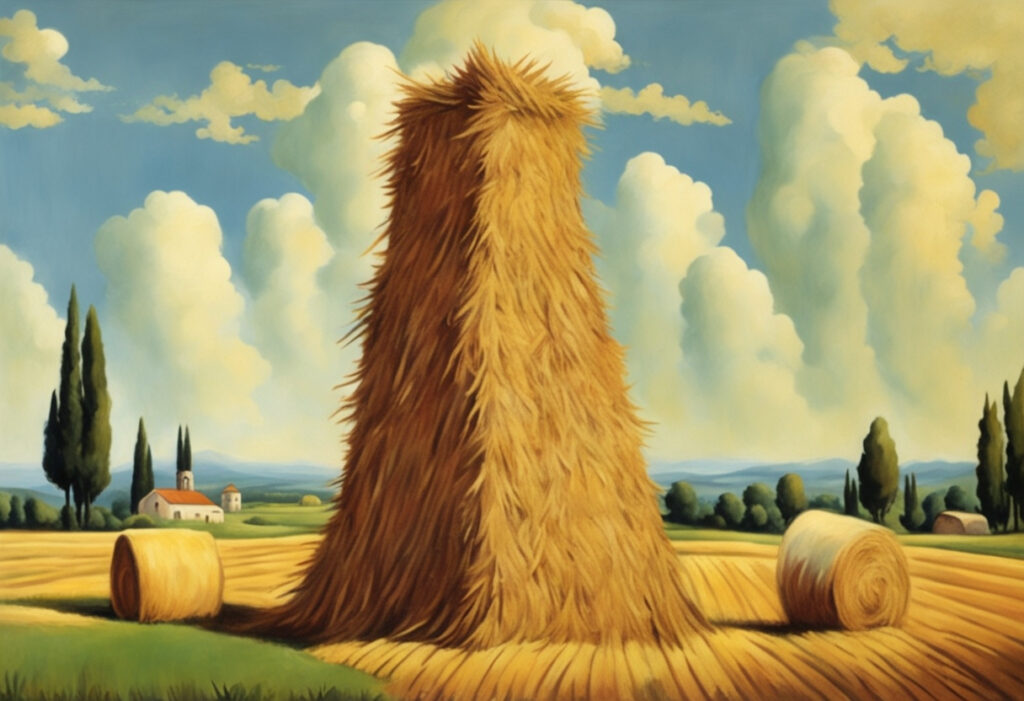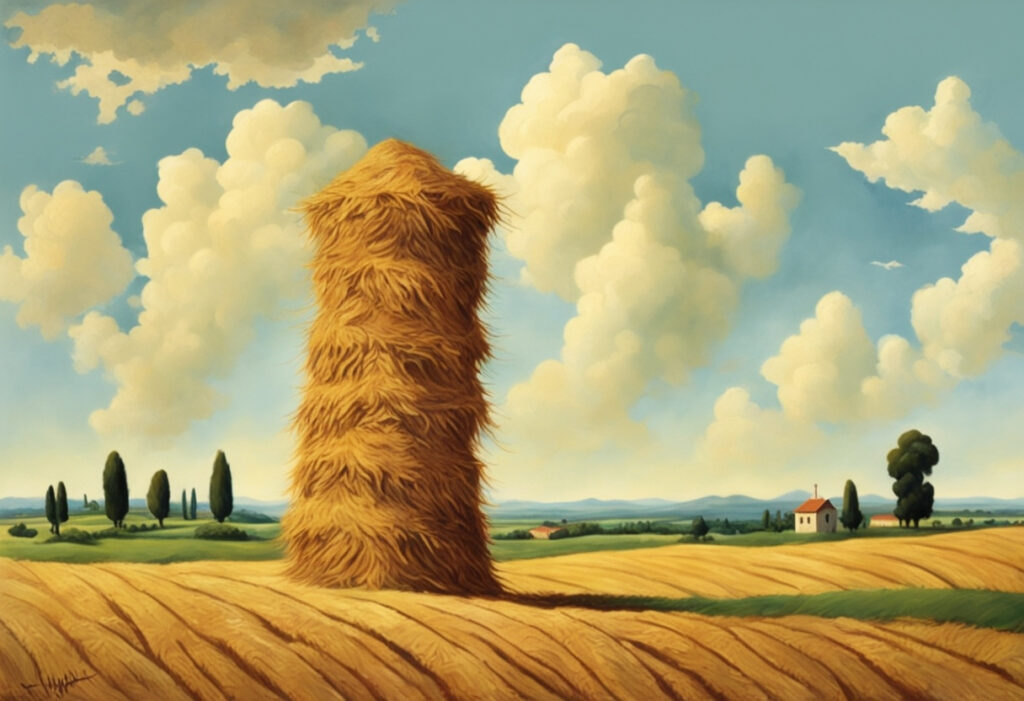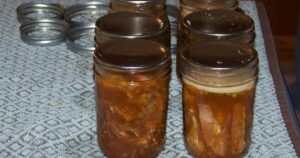
Farmer Who Paid Too Much Attention in High School Geometry Class.jpg
Farmer Who Paid Too Much Attention in High School Geometry Class Turns Haystacking into an Art Form: Practical? Maybe Not.
When Pythagoras Meets the Pasture: A Farmer’s Quest to Redefine Hay Bales
Bale Junction, TX — In the small town of Bale Junction, Texas, where ranching traditions run deep and hay bales are usually stacked in simple, efficient rows, one farmer has decided to challenge the status quo. Meet Clyde “Angles” McGee, a man whose high school obsession with geometry has finally found its moment in the sun—or rather, in the hayfield. But while Clyde’s haystacking methods are certainly eye-catching, locals are left wondering whether his geometrically precise creations actually serve any practical purpose.
The Birth of a Haystacking Revolution
It all started when Clyde, a farmer known for his meticulous nature, decided that the traditional method of stacking hay bales was, in his words, “a waste of spatial potential.” Armed with nothing but a protractor, some chalk, and a deep knowledge of Pythagorean theorem, Clyde set out to revolutionize the way hay was stacked on his farm.
“I just couldn’t help but think that there had to be a better way,” Clyde explained, standing proudly in front of his latest creation—a pyramid of hay bales arranged in a perfect isosceles triangle. “Why settle for boring old rows when you can have symmetry and beauty?”

Eyewitness Accounts: The Geometry of Hay
Clyde’s neighbors have been both amused and baffled by his unconventional approach to haystacking. “I’ve seen a lot of things in my time, but this takes the cake,” said Earl “Straight Rows” Jenkins, a local rancher. “Clyde’s got his bales stacked in shapes I didn’t even know existed. It’s like he’s building some kind of hay temple out there.”
Even the cows seem to be confused by Clyde’s geometric designs. One eyewitness reported seeing a herd of cattle staring blankly at a haystack shaped like a dodecahedron, seemingly unsure of how to approach it. “It’s like they’re scared to eat it,” said Hank “Round Bale” Thompson. “They probably think it’s some kind of modern art installation.”

Expert Insights: The Science Behind the Shapes
Dr. Tess Ellation, a professor of geometry at the local community college, was called in to assess Clyde’s haystacking methods. After examining his creations, Dr. Ellation concluded that while the designs were mathematically impressive, they might not be the most practical use of space.
“Clyde’s haystacks are a perfect example of form over function,” Dr. Ellation explained. “The shapes are beautiful, yes, but they don’t necessarily maximize storage efficiency. In fact, he might be losing valuable space with some of these designs. But if you’re looking for aesthetic appeal, he’s definitely got that covered.”

Public Opinion: A Farmer or an Artist?
The townsfolk of Bale Junction are divided on Clyde’s new approach to haystacking. Some see him as a visionary, a farmer who’s bringing art and science to the field in a way that’s never been done before. “I think it’s great,” said local artist Lila “Abstract” Whitepaw. “It’s like he’s turning farming into a form of self-expression. Why not make something beautiful while you work?”
Others, however, are more skeptical. “It’s a nice idea and all, but I’m not sure how practical it is,” said rancher Tom “Efficiency” Tumbleweed. “I mean, sure, it looks cool, but what happens when a storm hits? Those bales are gonna be rolling all over the place.”
Even the local critters have opinions on the matter. A group of barn cats was spotted using Clyde’s pyramid-shaped haystack as a climbing gym, while a family of raccoons appeared to have taken up residence in one of his more abstract designs. “It’s become a wildlife refuge,” joked Jolene Hayfield. “Who knew geometry could be so eco-friendly?”

Real-World Examples: The Limits of Geometric Farming
While Clyde’s haystacking methods are certainly unique, they’re not the first attempt to apply geometry to farming. In fact, history is filled with examples of farmers who tried to bring mathematical principles to the field—often with mixed results.
Take the case of Bill “The Circle” Simmons, a farmer from Iowa who believed that circular planting patterns would increase crop yields. While the crops looked beautiful from the air, Bill soon discovered that harvesting in circles was much more difficult than anticipated. “It was like trying to square a circle,” Bill later admitted. “Turns out, there’s a reason we plant in straight rows.”

Statistical Evidence: Does Geometry Really Save Space?
A study conducted by the Bale Junction Agricultural Society found that while geometric haystacking methods like Clyde’s are visually striking, they may not be the most space-efficient. According to the study, traditional row stacking allows for up to 20% more hay to be stored in the same amount of space compared to more complex shapes.
“It’s all about maximizing your storage,” said study author Rusty Nail. “Clyde’s methods are definitely creative, but if you’re looking to store as much hay as possible, the old-fashioned way still wins out.”

Textual Evidence: Geometry’s Role in Farming
The use of geometry in farming isn’t new. Ancient civilizations used geometric principles to design irrigation systems, build terraced fields, and even plant crops in specific patterns to maximize sunlight exposure. However, most of these applications were focused on practicality rather than aesthetics.
As one agricultural historian noted, “Geometry has always had a place in farming, but it’s usually been about function. Clyde’s approach is a bit different—he’s bringing art into the equation, which is both admirable and a little unconventional.”

Analogical Evidence: When Form Meets Function
Clyde’s haystacking methods can be seen as a metaphor for life: sometimes, the pursuit of beauty and perfection can come at the cost of practicality. Just as Clyde’s hay bales may not be the most efficient use of space, many of us spend time and energy on pursuits that, while fulfilling, may not always be the most productive.
In Bale Junction, Clyde’s approach has sparked a larger conversation about the balance between form and function. “It’s a lesson for all of us,” said Mayor Bale. “Sometimes you’ve got to ask yourself: am I doing this because it makes sense, or because it looks good? And if it’s the latter, is that okay?”

Hypothetical Evidence: What If Everyone Stacked Hay Like Clyde?
Imagine a world where every farmer embraced Clyde’s geometric approach to haystacking. Fields across the country would be transformed into intricate patterns of hay pyramids, spirals, and even fractals. While it might not be the most efficient use of space, it would certainly make for some impressive aerial photography.
But as much as some might dream of such a world, most farmers agree that it’s probably best to leave the geometry in the classroom. “There’s a reason we do things the way we do,” said rancher Buck Baleson. “It might not be fancy, but it works. And at the end of the day, that’s what matters.”

Insider Knowledge: How to Combine Art and Function on the Farm
For those inspired by Clyde’s creative approach, here are some insider tips on how to bring a little artistic flair to your farming without sacrificing practicality:
- Step-by-Step Guides: Start small. Try adding a touch of geometry to a corner of your haystack before committing to a full overhaul.
- Pro Tips: Balance aesthetics with functionality. If a design looks good but doesn’t work, it’s not worth the effort.
- Insider Knowledge: Use strong ties. Geometric stacks may need extra support to stay in place, especially in windy conditions.
- Expert Insights: Experiment with shapes that still maximize space. Not all geometric designs are inefficient—some can actually help you store more hay.
- Best Practices: Keep an eye on the weather. Beautiful designs are great, but they need to withstand the elements.
Pro Tips: How to Avoid Getting Too Caught Up in the Details
- Prioritize Function: While it’s fun to experiment, make sure that your efforts don’t compromise the practicality of your work.
- Stay Grounded: Remember that at the end of the day, your goal is to get the job done—don’t let the pursuit of perfection slow you down.
- Learn from Mistakes: If a design doesn’t work, don’t be afraid to go back to basics. There’s no shame in simplicity.
- Combine Creativity with Common Sense: You can have the best of both worlds by finding ways to make your farm both functional and visually appealing.
- Appreciate the Process: Enjoy the creative journey, but don’t lose sight of the end goal—keeping your farm running smoothly.

Disclaimer:
No hay bales were wasted—or turned into geometry lessons—in the making of this article. This story is a playful reflection on the intersection of art and farming, and is entirely a human collaboration between a geometry enthusiast and a writer who both agree that sometimes, it’s okay to just stack hay the old-fashioned way.
Top 10 Methods Clyde “Angles” McGee Uses to Stack Hay:
- The Pythagorean Pyramid: Clyde’s favorite—a perfect isosceles triangle made of hay bales, with each side meticulously measured. It looks impressive, but good luck getting those top bales down.
- The Fibonacci Spiral: Inspired by the famous sequence, Clyde arranges his hay bales in a spiral pattern that’s mathematically sound but spatially questionable.
- The Hexagonal Honeycomb: Borrowing from nature, Clyde stacks his bales in a hexagonal pattern, like a beehive. It’s stable, but it leaves a lot of gaps.
- The Dodecahedron Delight: A 12-faced shape that has the cows wondering if it’s food or modern art. This one is a favorite of the local cats for climbing.
- The Leaning Tower of Hay-sa: Clyde stacks his bales in a tilted cylindrical shape, reminiscent of Italy’s famous tower. It’s picturesque, but it always looks like it’s about to collapse.
- The Cubist Conundrum: Inspired by abstract art, Clyde stacks hay bales at odd angles, creating a three-dimensional puzzle that’s as confusing as it is unnecessary.
- The Sierpinski Triangle: A fractal-based design that involves stacking smaller and smaller triangles within a larger one. It’s complex, beautiful, and completely impractical.
- The Arch of Inefficiency: Clyde builds a hay arch, with bales balanced precariously in a curved formation. It’s an engineering marvel that serves no practical purpose on the farm.
- The Möbius Strip: A single continuous loop of hay bales twisted in a way that defies logic—and effective storage. It’s a conversation starter, if nothing else.
- The Perfect Parallelogram: Clyde stacks his bales in a slanted rectangle, which looks neat from afar but leaves gaps that could have been filled with more hay.



Originally Published at FarmerCowboy.com
2024-08-18 12:26:10
Karl Hoffman is a distinguished agriculturalist with over four decades of experience in sustainable farming practices. He holds a Ph.D. in Agronomy from Cornell University and has made significant contributions as a professor at Iowa State University. Hoffman’s groundbreaking research on integrated pest management and soil health has revolutionized modern agriculture. As a respected farm journalist, his column “Field Notes with Karl Hoffman” and his blog “The Modern Farmer” provide insightful, practical advice to a global audience. Hoffman’s work with the USDA and the United Nations FAO has enhanced food security worldwide. His awards include the USDA’s Distinguished Service Award and the World Food Prize, reflecting his profound impact on agriculture and sustainability.






